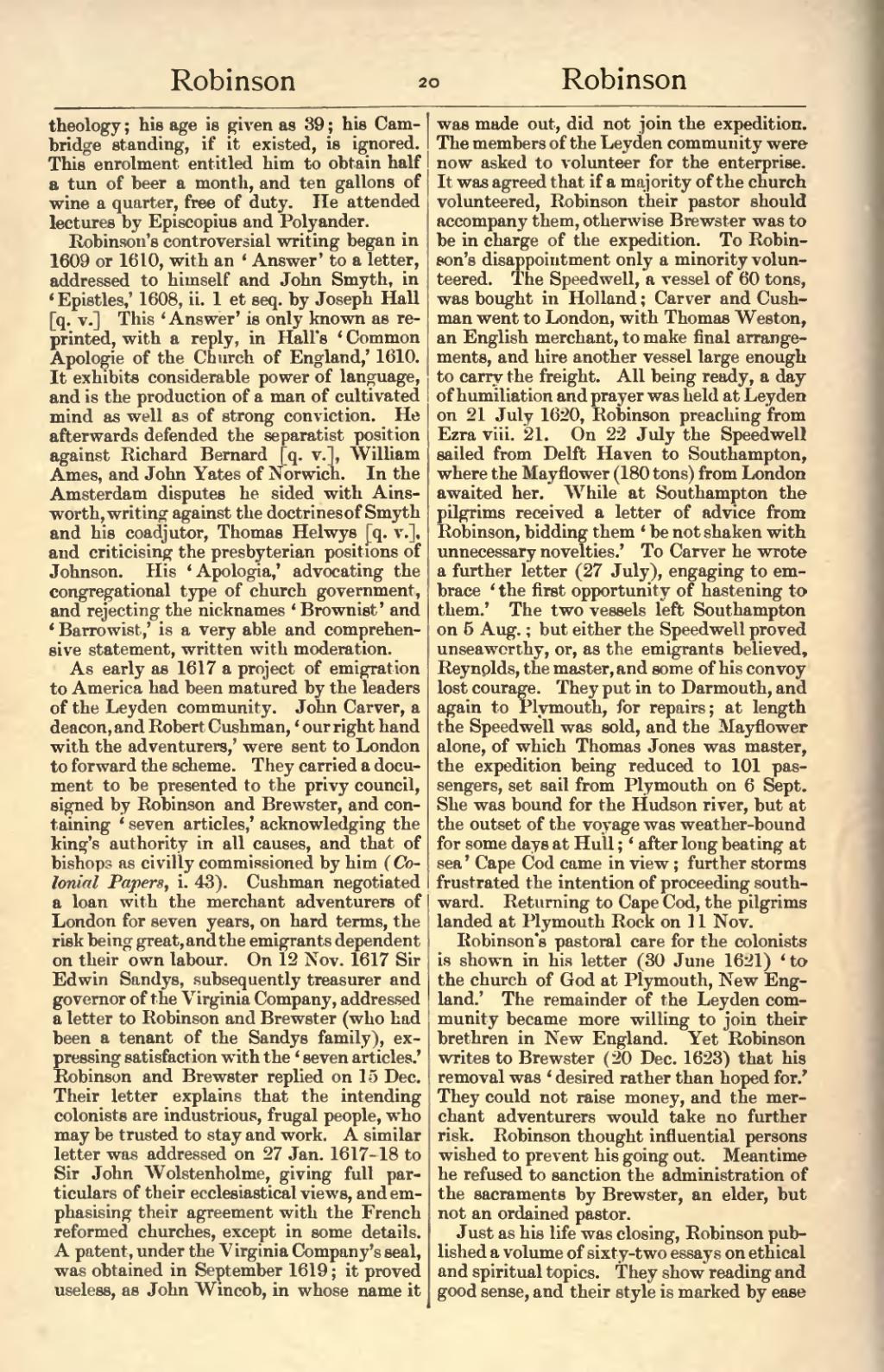theology; his age is given as 39; his Cambridge standing, if it existed, is ignored. This enrolment entitled him to obtain half a tun of beer a month, and ten gallons of wine a quarter, free of duty. He attended lectures by Episcopius and Polyander.
Robinson's controversial writing began in 1609 or 1610, with an ‘Answer’ to a letter, addressed to himself and John Smyth, in ‘Epistles,’ 1608, ii. 1 et seq. by Joseph Hall [q. v.] This ‘Answer’ is only known as reprinted, with a reply, in Hall's ‘Common Apologie of the Church of England,’ 1610. It exhibits considerable power of language, and is the production of a man of cultivated mind as well as of strong conviction. He afterwards defended the separatist position against Richard Bernard [q. v.], William Ames, and John Yates of Norwich. In the Amsterdam disputes he sided with Ainsworth, writing against the doctrines of Smyth and his coadjutor, Thomas Helwys [q. v.], and criticising the presbyterian positions of Johnson. His ‘Apologia,’ advocating the congregational type of church government, and rejecting the nicknames ‘Brownist’ and ‘Barrowist,’ is a very able and comprehensive statement, written with moderation.
As early as 1617 a project of emigration to America had been matured by the leaders of the Leyden community. John Carver, a deacon, and Robert Cushman, ‘our right hand with the adventurers,’ were sent to London to forward the scheme. They carried a document to be presented to the privy council, signed by Robinson and Brewster, and containing ‘seven articles,’ acknowledging the king's authority in all causes, and that of bishops as civilly commissioned by him (Colonial Papers, i. 43). Cushman negotiated a loan with the merchant adventurers of London for seven years, on hard terms, the risk being great, and the emigrants dependent on their own labour. On 12 Nov. 1617 Sir Edwin Sandys, subsequently treasurer and governor of the Virginia Company, addressed a letter to Robinson and Brewster (who had been a tenant of the Sandys family), expressing satisfaction with the ‘seven articles.’ Robinson and Brewster replied on 15 Dec. Their letter explains that the intending colonists are industrious, frugal people, who may be trusted to stay and work. A similar letter was addressed on 27 Jan. 1617–18 to Sir John Wolstenholme, giving full particulars of their ecclesiastical views, and emphasising their agreement with the French reformed churches, except in some details. A patent, under the Virginia Company's seal, was obtained in September 1619; it proved useless, as John Wincob, in whose name it was made out, did not join the expedition. The members of the Leyden community were now asked to volunteer for the enterprise. It was agreed that if a majority of the church volunteered, Robinson their pastor should accompany them, otherwise Brewster was to be in charge of the expedition. To Robinson's disappointment only a minority volunteered. The Speedwell, a vessel of 60 tons, was bought in Holland; Carver and Cushman went to London, with Thomas Weston, an English merchant, to make final arrangements, and hire another vessel large enough to carry the freight. All being ready, a day of humiliation and prayer was held at Leyden on 21 July 1620, Robinson preaching from Ezra viii. 21. On 22 July the Speedwell sailed from Delft Haven to Southampton, where the Mayflower (180 tons) from London awaited her. While at Southampton the pilgrims received a letter of advice from Robinson, bidding them ‘be not shaken with unnecessary novelties.’ To Carver he wrote a further letter (27 July), engaging to embrace ‘the first opportunity of hastening to them.’ The two vessels left Southampton on 5 Aug.; but either the Speedwell proved unseaworthy, or, as the emigrants believed, Reynolds, the master, and some of his convoy lost courage. They put in to Darmouth, and again to Plymouth, for repairs; at length the Speedwell was sold, and the Mayflower alone, of which Thomas Jones was master, the expedition being reduced to 101 passengers, set sail from Plymouth on 6 Sept. She was bound for the Hudson river, but at the outset of the voyage was weather-bound for some days at Hull; ‘after long beating at sea’ Cape Cod came in view; further storms frustrated the intention of proceeding southward. Returning to Cape Cod, the pilgrims landed at Plymouth Rock on 11 Nov.
Robinson's pastoral care for the colonists is shown in his letter (30 June 1621) ‘to the church of God at Plymouth, New England.’ The remainder of the Leyden community became more willing to join their brethren in New England. Yet Robinson writes to Brewster (20 Dec. 1623) that his removal was ‘desired rather than hoped for’ They could not raise money, and the merchant adventurers would take no further risk. Robinson thought influential persons wished to prevent his going out. Meantime he refused to sanction the administration of the sacraments by Brewster, an elder, but not an ordained pastor.
Just as his life was closing, Robinson published a volume of sixty-two essays on ethical and spiritual topics. They show reading and good sense, and their style is marked by ease
